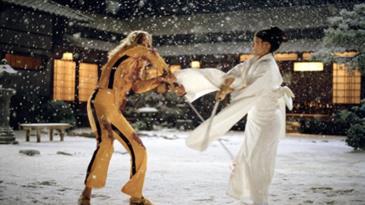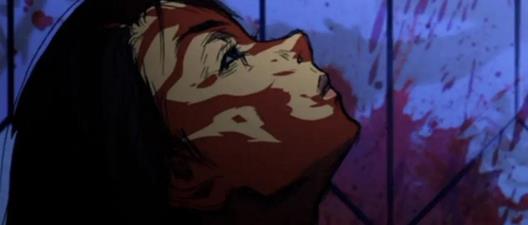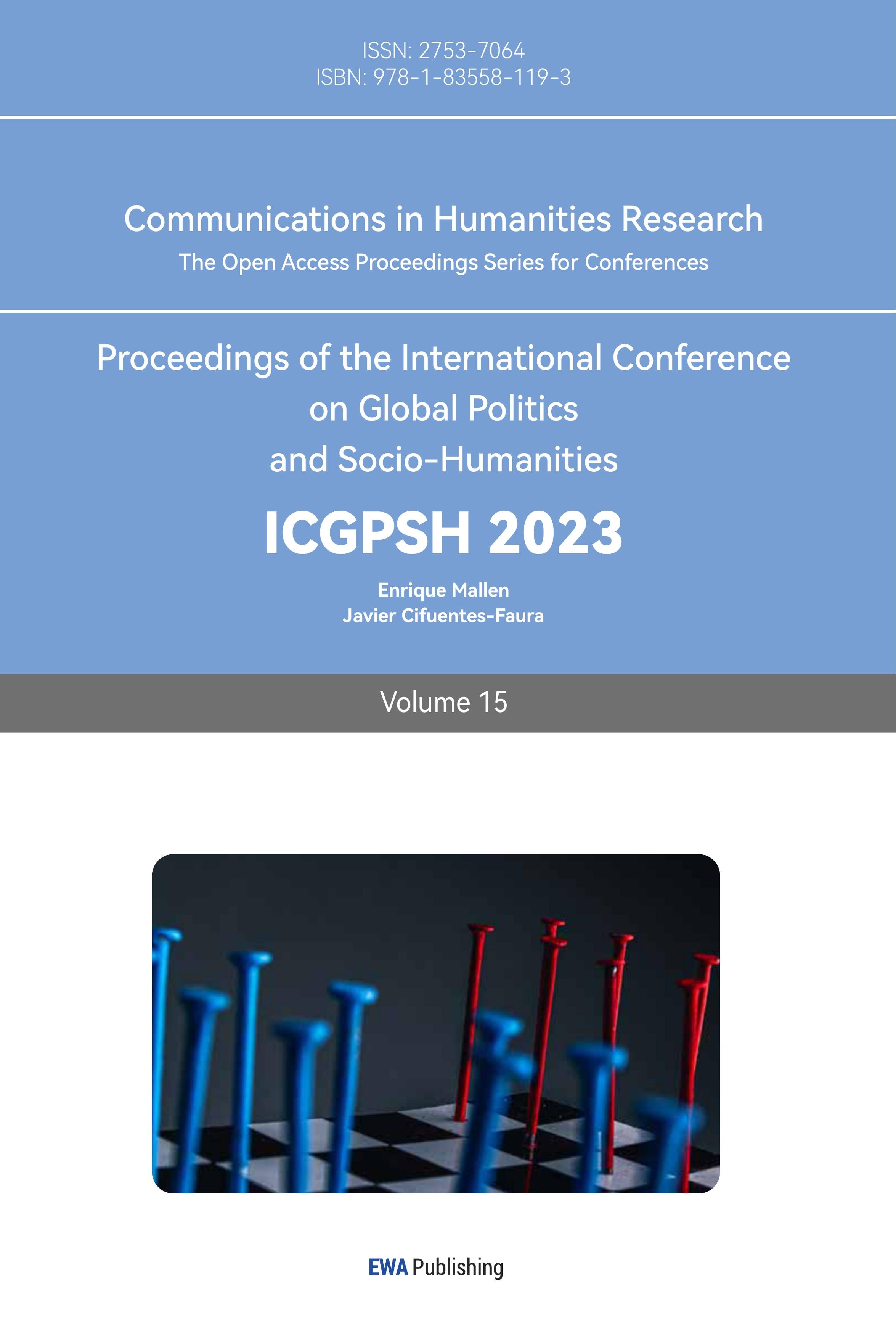1.Introduction
At present, there are many research results on violence aesthetics, but there are few cases that combine the research on violence aesthetics with the analysis of specific villains. The research theme of this paper is the violent aesthetic embodiment of the villain’s charm in the film. The film aesthetics will be explored through the use of color and lens language. In these three films, this paper analyzes the charming villains the ruthless Japanese underworld boss Ishii Yulian, the crazy and lovely clown Halle Quinn, and the beautiful and charming but bloody and violent prostitutes. This paper uses case analysis to explore the artistic presentation of violence aesthetics and explores more understanding of violence aesthetics. The concept of violence aesthetics first appeared in film criticism, which successfully combined the two incompatible concepts of violence and aesthetics, and attracted wide attention from all walks of life. The public’s explanation of violence is not controversial. Cihai defines violence as an act that causes physical or mental harm to others against their will. Violence in movies is a narrative element, which is generally reflected in the pictures of fighting, blood, crying and swords meeting, but the violent factors in movies provide room for the development of violent aesthetics [1].
2.Case Analysis of Violence Aesthetics - Kill Bill
2.1.Background Introduction
Bride used to be the killer of the Viper assassination team, trying to get rid of the bloody life by getting married, but the arrival of her colleague and everyone’s boss Bill ruined all this. Bill ignored Bride who was pregnant and shot her in the head. Bride, who survived, woke up in a hospital and immediately embarked on a revenge journey from Texas to Okinawa, Tokyo and Mexico.
2.2.Aesthetic Analysis
The film is visually colorful, with rich Japanese elements, bloody and intertwined, and the sword and shadow usher in great sensory stimulation. Exaggerated expression, profound dialogue and bloody scenes make Quentin’s violent style full of artistic sense. As shown as in Figure 1, in the scene of Bride’s duel with Yu Lian Ishii, Bride wears a bright yellow costume and turns it into a martial arts costume to pay tribute to Bruce Lee, which is very abrupt in the background full of black men. Yellow is a bright and eye-catching color with high saturation, whereas the color of Bride’s clothing promotes the narrative. This “bright look” that is out of tune with the surrounding color environment firmly catches the audience’s eye and confirms the theme that needs attention in the picture, thus strengthening the expressive force of the story and the tension of the picture. On the other hand, Yu Lian Ishii’s clothes, the traditional Japanese clothing version, are pure white in color, almost blending with the white snow in the background. In sharp contrast with the red color of blood, it highlights the cruel aesthetic feeling. Here, the color of Yu Lian Ishii’s dress hints at the relationship between the two characters, and the high coincidence of Ishii and the background almost hints at her objectiveness here, which also paves the way for the subsequent plot development of candidly admitting defeat.
`

Figure 1: The decisive battle scene in Kill Bill.
Kill Bill is deeply influenced by Japanese culture. There is a Japanese animation in the Japanese assassin O-Ren Ishii in the film (Figure 2). Quentin presents the experience of “Hundred Steps Snake” Ishii Yulian from an ignorant child to a top killer in the form of Japanese-style animation. At the beginning of the animation, Ishii, a young child, reproduces the scene where she witnessed her parents being brutally killed by Japanese violent gangs at home. In Japanese animation, there are many exaggerated images of children or teenagers protagonists. They often have the intelligence and wisdom that adults can’t match, and the power or potential to defeat the bad guys. In animation, the protagonists are almost perfect, powerful and reliable adult figures, who will overcome all kinds of difficulties and obstacles and assume the responsibility of protecting women and children and saving the world. This difference is precisely due to the different national psychology and the pursuit of visual images between the two countries. In addition, unlike ordinary children’s animation, there are many bloody and violent scenes describing killing and death in this animation, which has the typical characteristics of adult animation. In Japanese adult animation, there are many violent, bloody and cruel death scenes, which should show a heavy mood, but produce a sad beauty and create another atmosphere. In the film, the gushing blood and fierce fighting make the tragic and cruel killing scene have a great visual impact, while the dark color setting of the picture reflects the artistic aesthetics of Japanese ukiyo-e painting.

Figure 2: Anime clips in Kill Bill.
On the basis of in-depth study of Japanese animation, Quentin used Japanese-style animation to express violent scenes, which not only skillfully resolved the discomfort that too many real bloody scenes might bring to the audience, but also perfectly interpreted the personality style of violent aesthetics, fully reflecting his personal understanding and aesthetic orientation of Japanese animation, and was a tribute to Japanese traditional animation [2]. Although this is an animated version of the story, it is as barbaric and disturbing as the rest of the film. In this live-action movie, animation may exist to reduce the bloodshed in reality and reduce the overall violence of the movie. But if we contact the director Quentin Tarantino’s consistent film style-violence aesthetics. Kill Bill uses images, colors, sounds and words to over-express and exaggerate the reality of violence, war and revengel. Whether she chooses sinister revenge methods or hurts the daughter of her enemy, it violates the procedural justice and moral spirit of revenge, which is despised by her who follows the Bushido. In Bushido, Tatsu Yamashiro symbolizes the warrior’s strength, courage, loyalty and reputation, and is the place where the warrior’s soul rests, also known as the “warrior’s soul”. Shimada Hanzo of Hattori presented the most satisfactory work in his life to the “bride” by giving a knife ceremony, which was precisely in accordance with the provisions of the “ceremony” in Bushido to express recognition and respect for the samurai identity of the “bride” [3].
2.3.Lens Language
At the same time, the lens angle also shows the relationship between characters and implies the development of the plot. In all of Bride’s memories, several of her enemies looked at her from the perspective of overlooking.

Figure 3: The perspective before Bride was “killed” in Kill Bill.
Through the camera’s back shot, this shot is full of oppression, suggesting the relationship between Bride and four enemies in the past and the secondary position with Bride (Figure 3). Looking at people’s faces from bottom to top will give people a kind of physical fear (Figure 4), because people will feel that they are in a passive and fragile state and have a strong sense of the unknown.
2.4.Summary and Sublimation
Kill Bill reveals the violent side of human beings, which runs counter to traditional values and is regarded as “evil”. However, this film looks at the dark side of human nature objectively and even romanticizes it by artistic means. The “romantic” violent narration and absurd plot setting eliminate the violence itself and give the audience a chance to keep a certain distance from the film, so as to observe and reflect calmly. In Quentin’s violent films, “revenge-oriented” women are in the majority. In the films, women have been brutally injured or witnessed their loved ones being killed. They are unwilling to be the foil of men, and then they become the protagonists of the films from the edge to the center. These women have considerable autonomy in behavior, and their revenge path is relatively rational. The audience often unconsciously feels sympathy for these women. In other words, Quentin passes the female violence through the telephoto works [4]. In Kill Bill, it can be seen a law that Quentin describes the power of women. For example, Bride, the protagonist and bride, fearlessly avenged herself and the stillborn child, and Yu Lian Ishii’s calmness and strength. Quentin gave these female characters in the film the same strength and courage as men, both psychologically and militarily. The concept of violence aesthetics first appeared in film criticism, which successfully combined the two incompatible concepts of violence and aesthetics, and attracted wide attention from all walks of life. The public’s explanation of violence is not controversial. Cihai defines violence as an act that causes physical or mental harm to others against their will. Violence in movies is a narrative element, which is generally reflected in the pictures of fighting, blood, crying and swords meeting, but the violent factors in movies provide room for the development of violent aesthetics [5].
3.Case analysis of Suicide Squad
3.1.Aesthetic Analysis
Modeling as a symbol of civilization, color is more realistic. Give it strong vitality. The film’s color originating from nature is closely related to the color of literature and painting. The inter-disciplinary relationship makes the film absorb many elements of art, while the film color draws nutrition from many disciplines, such as physiological visual perception, art psychology, literature, painting and so on, which to some extent accumulates the cognition of the film color law, and is applied to film creation and aesthetic experience with the help of artistic attainments and cultural cognition. The artistic consciousness of film color composition runs through the film director’s color thinking all the time, which also marks the film color entering the process of modern speculation [6]. The visual color of the film is bright and rich. In the scene where Harry Quinn escapes from the tied scene and kills the guards and breaks through the encirclement, Harry Quinn wears a red skirt, which forms a bright color contrast with the fair skin. The color saturation is high and the tension of the picture is enhanced. The color of the dress also highlights Harry Quinn’s crazy gender characteristics. As shown as in Figure 5, in the process of killing the guards, Harry Quinn holds two guns, splashes blood and flowers, and expresses the plasma in the form of a sea of flowers.

Figure 4: The scene of Harry Quinn being escorted on the road in Suicide Squad 2.
On the way of Harry Quinn being escorted to the president, Harry wore a red dress in the scene, which created an unbalanced visual conflict with the green of the soldiers beside him and a sense of balance created by the symmetrical composition. The whole picture wavered between balance and imbalance (Figure 4).
3.2.Summary and Sublimation
The theme of the film actually discusses whether the transformation of nature by human beings is good or bad. The secret experiment of the government and the appearance of the alien starfish all metaphor the relationship between man and nature. The film expresses it in an exaggerated way and dramatizes it in an artistic way, and analyzes the harmonious coexistence between man and nature to the audience.
4.Case of Sin City
4.1.Background Introduction
Dwight went home with Shirley, a bar girl, but Jackie, who thought he was Shirley’s boyfriend, came to Shirley with several men. After being warned, Jackie fled despondently, thinking of the old city where prostitutes lived in anger and having fun, and died at the hands of prostitutes. It turned out that the beautiful and charming prostitutes were the real rulers of this evil city. In this city, fighting evil with evil is the rule, and violence and blood are everywhere. When Dwight looked at the body, he found that Jackie was a policeman.
4.2.Summary and Sublimation
Sin City interprets the unique visual artistic effect in the film through the mutual penetration and influence of film language and comic language. Based on the analysis of the film, it is not difficult to see that comics and movies are, after all, two completely different forms of artistic expression. Although Sin City is based on the original comic book and is extremely faithful to the original picture, it does not mean that the art design of the film can be in an absent position. Film art plays an important role in cultivating the audience’s mood and conveying the director’s intention. Under the presentation of violent aesthetics, the audience can see the power of guns, sticks and fists. This hearty expression is quite exaggerated, but it shows that the people at the bottom and even the authorities at the bottom hate corruption and evil, and promotes social justice in the process of cracking down on evil again and again, pushing the evil abyss of human nature far away.
5.Conclusion
The so-called “violence aesthetics” refers to the sense that violence is presented in an artistic way, and poetic pictures and even fantasy shots are used to express human violence and violence. Viewers themselves are often amazed at the artistic expression, and can’t have specific discomfort with the content. First, from the perspective of film aesthetics, violence aesthetics is an artistic innovation. Second, from the moral essence, the aesthetics of violence is a profound revelation and vigilance of human nature. There is an inherent biological basis for human beings to take violent actions when dealing with contradictions, or to take violent behaviors. In movies, exaggerated images are used to build the audience’s sense of violence, break the mediocre and daily life experience of ordinary people, show a more real human world than daily life, and profoundly reveal the ugly and dark side of human nature. Violence aesthetics has sounded the alarm for understanding the essence of human nature, so that human beings can neither overestimate the goodness of human nature nor underestimate the evil of human nature, and always remain alert to the real human nature.
In addition, from the perspective of psychological healing, the aesthetics of violence releases people’s anxiety and fear of death, which is the most primitive instinct of human beings. In essence, violent attack is a direct externalization of human death instinct, a peep of human death, and this is also the fundamental reason why “human nature itself is aggressive”. The violent display of this virtual scene is more open, exciting and diverse. Compared with literary works, the description of violence in film and television works is more intuitive and vivid, so it has become the best choice for people to vent their attack energy. “Violence Aesthetics” is precisely to grasp people’s curiosity of “peeping at death” and firmly grasp the audience’s eyes with the violent and bloody scenes after aesthetic treatment. The description of violence and death in the film actually contains a strong instinct for human survival on the back. The process of audience watching “violent aesthetics” movies is actually a way to release death anxiety. This is why “violence aesthetics” has been loved by countless fans since its birth, and it is also the reason why “violence aesthetics” has successfully formed and formed its own school.
References
[1]. Qi, T. (2021) On the Application of Violence Aesthetics in Commercial Films - Taking Quentin Tino’s Works as an Example [J] west china broadcasting tv, vol. 42, no18, pp.103-105.
[2]. Su, L. (2023) On the Application of Japanese Cultural Elements in Hollywood Movies [J] Tianjin University of Technology Language and Culture College, vol217, pp.172-174.
[3]. Tong, L. & Yi, Z. (2020) Feminist expression in Kun-style violence aesthetics [J] Social science series 2, vol.8, pp.119-121.
[4]. Tong, L. & Yi, Z. (2020) Feminist expression in Kun-style violence aesthetics [J] Social science series 2, vol8, pp.122-123.
[5]. Yang, L. (2012) Research on the Art of Film Color Composition [D] Philosophy and Humanities in Chongqing University, vol01, pp.8-10.
[6]. Xin, X. (2001) Research on the Application of Color in Film Language [D] Full-text Database of Excellent Master’s Dissertations in China, 2001, pp.39-41.
Cite this article
Zhang,Y. (2023). The Violent Aesthetic Embodiment of the Charm of the Villains in the Films. Communications in Humanities Research,15,18-24.
Data availability
The datasets used and/or analyzed during the current study will be available from the authors upon reasonable request.
Disclaimer/Publisher's Note
The statements, opinions and data contained in all publications are solely those of the individual author(s) and contributor(s) and not of EWA Publishing and/or the editor(s). EWA Publishing and/or the editor(s) disclaim responsibility for any injury to people or property resulting from any ideas, methods, instructions or products referred to in the content.
About volume
Volume title: Proceedings of the International Conference on Global Politics and Socio-Humanities
© 2024 by the author(s). Licensee EWA Publishing, Oxford, UK. This article is an open access article distributed under the terms and
conditions of the Creative Commons Attribution (CC BY) license. Authors who
publish this series agree to the following terms:
1. Authors retain copyright and grant the series right of first publication with the work simultaneously licensed under a Creative Commons
Attribution License that allows others to share the work with an acknowledgment of the work's authorship and initial publication in this
series.
2. Authors are able to enter into separate, additional contractual arrangements for the non-exclusive distribution of the series's published
version of the work (e.g., post it to an institutional repository or publish it in a book), with an acknowledgment of its initial
publication in this series.
3. Authors are permitted and encouraged to post their work online (e.g., in institutional repositories or on their website) prior to and
during the submission process, as it can lead to productive exchanges, as well as earlier and greater citation of published work (See
Open access policy for details).
References
[1]. Qi, T. (2021) On the Application of Violence Aesthetics in Commercial Films - Taking Quentin Tino’s Works as an Example [J] west china broadcasting tv, vol. 42, no18, pp.103-105.
[2]. Su, L. (2023) On the Application of Japanese Cultural Elements in Hollywood Movies [J] Tianjin University of Technology Language and Culture College, vol217, pp.172-174.
[3]. Tong, L. & Yi, Z. (2020) Feminist expression in Kun-style violence aesthetics [J] Social science series 2, vol.8, pp.119-121.
[4]. Tong, L. & Yi, Z. (2020) Feminist expression in Kun-style violence aesthetics [J] Social science series 2, vol8, pp.122-123.
[5]. Yang, L. (2012) Research on the Art of Film Color Composition [D] Philosophy and Humanities in Chongqing University, vol01, pp.8-10.
[6]. Xin, X. (2001) Research on the Application of Color in Film Language [D] Full-text Database of Excellent Master’s Dissertations in China, 2001, pp.39-41.









